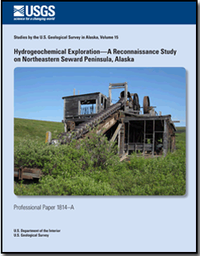Hydrogeochemical Exploration: A Reconnaissance Study on Northeastern Seward Peninsula, Alaska
Links
- Document: Report (1.8 MB pdf)
- Larger Work: This publication is Chapter A of Studies by the U.S. Geological Survey in Alaska, Volume 15
- Download citation as: RIS | Dublin Core
Abstract
A reconnaissance hydrogeochemical study employing high-resolution/high-sensitivity inductively coupled plasma mass spectrometry analysis of stream and seep water samples (n= 171) was conducted in an area of limited bedrock exposure on the northeastern Seward Peninsula, Alaska. Sampling was focused in drainages around four main areas—at the Anugi Pb-Zn-Ag occurrence and in streams upstream of historically and currently mined placer gold deposits in the Candle Creek, Utica, and Monument Mountain areas. The objective of the study was to determine whether distribution of elevated metal concentrations in water samples could “see” through sediment cover and provide evidence of bedrock sources for base metals and gold. Some observations include (1) elevated Ag, As, Pb, and Zn concentrations relative to the study area as a whole in stream and seep samples from over and downstream of part of the Anugi Pb-Zn-Ag prospect; (2) abrupt downstream increases in Tl and Sb ± Au concentrations coincident with the upstream termination of productive placer deposits in the Inmachuk and Old Glory Creek drainages near Utica; (3) high K, Mo, Sb, and F throughout much of the Inmachuk River drainage near Utica; and (4) elevated As ± base metals and Au at two sites along Patterson Creek near the town of Candle and three additional contiguous sites identified when an 85th percentile cut-off was employed. Molybdenum ± gold concentrations (>90th percentile) were also measured in samples from three sites on Glacier Creek near Monument Mountain. The hydrogeochemistry in some areas is consistent with limited stream-sediment data from the region, including high Pb-Zn-Ag-As concentrations associated with Anugi, as well as historical reports of arsenopyrite-bearing veins upstream of placer operations in Patterson Creek. Chemistry of samples in the Inmachuk River-Old Glory Creek area also suggest more laterally extensive stibnite- (and gold-?) bearing veining than is currently known in the Old Glory Creek drainage. Our results indicate that hydrogeochemistry can be a useful method of geochemical exploration and offer targets for follow-up rock, soil, and subsurface sampling to ascertain the presence of mineralized bedrock.
Suggested Citation
Graham, G.E., Taylor, R.D., Buckley, S., 2015, Hydrogeochemical exploration: a reconnaissance study on northeastern Seward Peninsula, Alaska: U.S. Geological Survey Professional Paper 1814, v, 16 p., https://doi.org/10.3133/pp1814A.
ISSN: 2330-7102 (online)
Study Area
| Publication type | Report |
|---|---|
| Publication Subtype | USGS Numbered Series |
| Title | Hydrogeochemical exploration: a reconnaissance study on northeastern Seward Peninsula, Alaska |
| Series title | Professional Paper |
| Series number | 1814 |
| Chapter | A |
| DOI | 10.3133/pp1814A |
| Year Published | 2015 |
| Language | English |
| Publisher | U.S. Geological Survey |
| Publisher location | Reston, VA |
| Contributing office(s) | Alaska Science Center Geology Minerals |
| Description | v, 16 p. |
| Larger Work Type | Report |
| Larger Work Subtype | USGS Numbered Series |
| Larger Work Title | Studies by the U.S. Geological Survey in Alaska, vol. 15 (Professional Paper 1814) |
| Country | United States |
| State | Alaska |
| Other Geospatial | Seward Peninsula |
| Online Only (Y/N) | Y |
| Additional Online Files (Y/N) | N |


